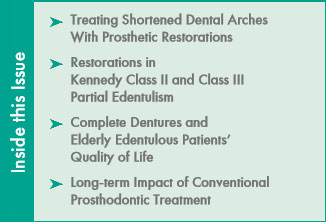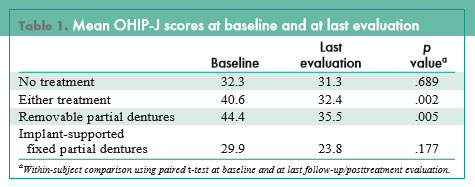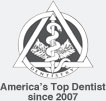Prosthodontics Newsletter Focusing on Dental Implants

Quality of Life as an Objective in Prosthodontics
Frequently cited reasons for seeking high-quality prosthodontic therapy include superior esthetics, functional improvement, enhanced phonetics and elimination of pain. While a single measure, such as masticatory ability, may shed light on one important aspect of oral health, the holistic concept of oral health–related quality of life provides a broader insight into prosthodontics’ impact on patients’ systemic health and well-being. This issue of Prosthodontics Newsletter reviews recent studies that evaluate the effects of treatment on patients’ oral health–related quality of life.
Chewing Ability and Health in the Elderly Population
Because nutritional status can be related to chewing ability, it is an area in which oral health has a significant impact on quality of life (QoL). Unfortunately, studies analyzing the influence of oral health–related quality of life (OHRQoL) on nutritional status have been plagued by significant differences among indicators and assessment tools employed. Using noninvasive tests that eliminated personal preference of foods, Lee et al from Kaohsiung Medical University, Taiwan, conducted a study to determine the interplay be- tween chewing ability, nutritional status and general QoL.
The study comprised 954 people aged ≥65 years (mean age, 74 years) who had completed the 14-item Taiwanese Oral Health Impact Pro file (OHIP-14T)—which includes 2 items focused on chewing ability— and the 36-Item Short Form Health Survey (SF-36), a widely used questionnaire that evaluates physical and mental health. Basic demographic information, along with nutritional and general health statuses, were also recorded.
A regression analysis showed that people with better chewing ability had lower scores on the OHIP-14T, meaning they had a better OHRQoL and were less likely to be underweight. Better chewing ability also correlated with better physical and mental health scores on the SF-36.
Comment

This study suggested that chewing ability is the most significant OHRQoL indicator for both nutritional status and general QoL among the elderly. Steps that re- store, maintain or improve a patient’s ability to chew should be taken to promote physical and mental health in this population.
Lee I-C, Yang Y-H, Ho P-S, Lee I-C. Chewing ability, nutritional status and quality of life. J Oral Rehabil 2014;41:79-86.
Treating Shortened Dental Arches With Prosthetic Restorations
Patients with shortened dental arches experience partial edentulism, with most of the posterior teeth missing. Accepted practice has been to restore teeth only as far as the premolars, leaving the molars unrestored; several studies support this choice. However, Fueki et al from Tokyo Medical and Dental University, Japan, conducted a multicenter investigation to explore whether treatment with either removable partial dentures or implant-supported fixed partial dentures would improve patients’ oral health– related quality of life (OHRQoL).
The researchers studied 125 patients from 7 university-based dental hospitals in both urban and rural areas. All patients had Kennedy class I or class II partially edentulous spaces posterior to the canines, totaling 2 to 12 missing occlusal units (a pair of occluding premolars equaling 1 unit; a pair of occluding molars equaling 2 units).
Patients were offered their choice of treatment:
- no treatment (n = 53)
- treatment with clasp-retained removable partial dentures (n = 53)
- treatment with implant-supported fixed partial dentures (n = 19)
To measure OHRQoL, patients completed the Japanese version of the Oral Health Impact Profile (OHIP-J) at entry into the study, and then at 3-, 6- and 12-month intervals after the baseline evaluation.
All 125 participants underwent ≥1 follow-up visits; among them, 78 underwent 3 follow-up visits, 19 underwent 2 and 28 underwent 1. OHIP-J scores for patients who chose no treatment saw no significant change through their last follow-up visit, while the treated patients saw a significant drop (improvement) in their OHIP-J scores. Patients receiving removable partial dentures, who had worse OHIP-J scores at baseline, showed the greatest improvement (Table 1).

Comment
The results of this study appeared to challenge the conventional wisdom concerning treatment for patients with shortened dental arches. Prosthetic restorations should be considered an option for these patients to improve their OHRQoL.
Fueki K, Igarashi Y, Maeda Y, et al. Effect of prosthetic restoration on oral health-related quality of life in patients with shortened dental arches: a multicentre study. J Oral Rehabil 2015;42:701-708.
Restorations in Kennedy Class II And Class III Partial Edentulism
Innumerable studies have shown improvement in oral health– related quality of life (OHRQoL) following restoration using implants in partially edentulous paitients, especially in patients receiving removable dentures and fixed dental prostheses. However, little is known about the effect of an earlyloaded, 2–implant-supported fixed dental prosthesis on the OHRQoL of patients with Kennedy class II and class III edentulism.
Using 3-unit fixed dental prostheses supported by 2 implants in the molar/premolar area, van Eekeren et al from the Academic Centre of Dentistry Amsterdam, the Netherlands, treated 14 patients with Kennedy class II edentulism and 20 patients with Kennedy class III edentulism. No patients required bone augmentation or regeneration procedures to create adequate bone height and width for implant placement. The restoration protocol called for loading implants with a porcelain fused-to-metal fixed dental prosthesis 3 weeks after surgery.
Patient OHRQoL was measured by the Dutch version of the Oral Health Impact Profile-14 (OHIP14NL), which was completed at the time of entrance to the study, 2 weeks after implant surgery and 1 year after loading. Total possible scores on the OHIP-14NL range from 0 to 56, with lower scores associated with better OHRQoL.
Both Kennedy class II and class III patients showed significant improvement from their mean baseline OHIP-14NL scores to their scores at 2 weeks post surgery and at 1 year after loading.
- All patients improved from 6.5 to 2.4 to 0.9.
- Kennedy class II patients im- proved from 4.8 to 1.5 to 1.1.
- Kennedy class III patients im- proved from 8.9 to 3.6 to 0.8.
Comment
This small study showed patients’ significant OHRQoL improvements even before the implants were restored, which may suggest that their perceptions could have been affected by the mere fact that restorative therapy had begun. Nevertheless, the perceived improvement continued in both Kennedy class II and class III patients well after the fixed dental restorations were placed.
van Eekeren PJA, Aartman IHA, Tahmaseb A, Wismeijer D. The effect of implant placement in patients with either Kennedy class II and [sic] III on oral health-related quality of life: a prospective clinical trial. J Oral Rehabil 2016;43:291-296
Complete Dentures and Elderly Edentulous Patients’ Quality Of Life
The need to study the impact of complete dentures on oral health–related quality of life (OHRQoL) in the elderly in- creases as the population ages. Yet, while the relationship between patient expectations and satisfaction after complete denture therapy is well established for specific areas of oral health, little work has been performed to ascertain the impact of such therapy on OHRQoL.
Sivakumar et al from Vishnu Dental College, India, enrolled 60 elderly edentulous patients (age range, 55–81 years) to measure changes in OHRQoL after complete denture therapy and to explore whether patients’ initial expectations affected their self-perceived OHRQoL. Patients generally came from a lower socioeconomic group and had a primary class education.
At baseline, patients completed 2 questionnaires: an expectation assessment containing 1 question about esthetics and 1 question about function, and a shortened version of the Oral Health Impact Profile (OHIP-EDENT; Table 2) containing 19 items/questions related to the 7 domains of
- functional limitation
- physical pain
- psychological discomfort
- physical disability
- psychological disability
- social disability
- handicap

Possible scores in each domain ranged from 0 to 4, with higher numbers reflecting increased levels of dysfunction, discomfort and disability. The patients retook the OHIP-EDENT at 1 month and 6 months after treatment ended.
OHIP-EDENT scores were significantly reduced (improved) for all domains at 1 month post treatment. At 6 months, scores for all domains continued to improve; the sum of all scores improved by 83% from pretreatment scores. No difference was found in final scores be tween those who entered treatment with moderate expectations and those who entered with high expectations
Comment
This study showed that elderly edentulous patients had improved OHRQoL after complete denture therapy, which was not significantly influenced by patients’ moderate or high expectations of success. Complete dentures remain an attractive alternative for this population.
Sivakumar I, Sajjan S, Ramaraju AV, Rao B. Changes in oral health-related quality of life in elderly edentulous patients after complete denture therapy and possible role of their initial expectation: a follow-up study. J Prosthodont 2015;24:452-456.
Long-term Impact Of Conventional Prosthodontic Treatment
Studies have shown that a large majority of patients feel better after receiving fixed, removable and complete dentures, and survival rates for the prostheses are excellent. Because studies about the impact of prosthodontic restorations on long-term oral health– related quality of life (OHRQoL are lacking, Aarabi et al from the University Medical Center Hamburg-Eppendorf, Germany, tracked the OHRQoL of 272 patients over a 2-year period.
The patients (mean age, 59.5 ± 13.8 years; range, 22–86 years) received either fixed dental prostheses (46.3%), removable dental prostheses (45.6%) or complete dentures (8.1%). Be fore treatment began, at 4 to 6 weeks after treatment ended, and at 6, 12, 18 and 24 months, patients completed the German version of the Oral Health Impact Profile (OHIP-G), a 49-item questionnaire that evaluates OHRQoL.
On the OHIP-G, answers for each item concerning the frequency of oral health–related problems in the past month range from 0 (never) to 4 (very often). The potential total score can range from 0 to 196, with a lower score reflecting a better outcome.
OHIP-G scores dropped significantly for all groups at 6 months By 24 months, the scores had in- creased but were still lower than they had been at baseline. Patients receiving removable dental prostheses showed the greatest improvement at all time points except 24 months, at which time patients receiving complete dentures showed the greatest improvement (Table 3).
Comment
Patients reported better OHRQoL after conventional prosthodontic rehabilitation, with the positive effect continuing at 2 years. While many factors influence a patient’s OHRQoL, prosthodontic treatment appears to be a substantial factor in patients’ perceptions of their oral health.
Aarabi G, John MT, Schierz O, et al. The course of prosthodontic patients’ oral health-related quality of life over a period of 2 years. J Dent 2015;43:261-268.
In the Next Issue
State-of-the-art applications for zirconia in implant prosthodontics.
Our next report features a discussion of these issues and the studies that analyze them, as well as other articles exploring topics of vital interest to you as a practitioner.
Do you or your staff have any questions or comments about Prosthodontics Newsletter? Please write or call our office. We would be happy to hear from you.

 (425) 549-4649
(425) 549-4649








Please login to publish a comment.
Comments (0)